Your opinion & share...
Latest topics
Search
Who is online?
In total there are 103 users online :: 0 Registered, 0 Hidden and 103 Guests None
Most users ever online was 387 on Tue Dec 05, 2023 7:35 pm
Moderators & partners
Most Viewed Topics
Statistics
We have 5933 registered usersThe newest registered user is Skylines3
Our users have posted a total of 47502 messages in 4941 subjects
Top posting users this week
| No user |
Recommendations
• The FREE hand reading services at the Modern Hand Reading Forum are being continued in 2019 with the assistance of Google adsense!

MAJOR HAND READING SYNONYMS
Palmistry, Palm Reading, Hand Analysis, Chirology & Chiromancy. Learn how to read hands according the Modern Hand Reading paradigm & you can use this forum as your palm reading guide!
Simian line: advanced considerations!
+2
zaobhand
Martijn (admin)
6 posters
Modern Hand Reading Forum - Discover the language of your hands: palm reading & palmistry forum! :: III - MODERN HAND READING - Various systems for reading hands! :: IIIa - Modern Palmistry: general topics, questions
Page 1 of 1
 Simian line: advanced considerations!
Simian line: advanced considerations!
Example of a (complete) 'simian line': a complete fusion of the heart line and head line - which usually results in the impression that one of both lines appears to be missing!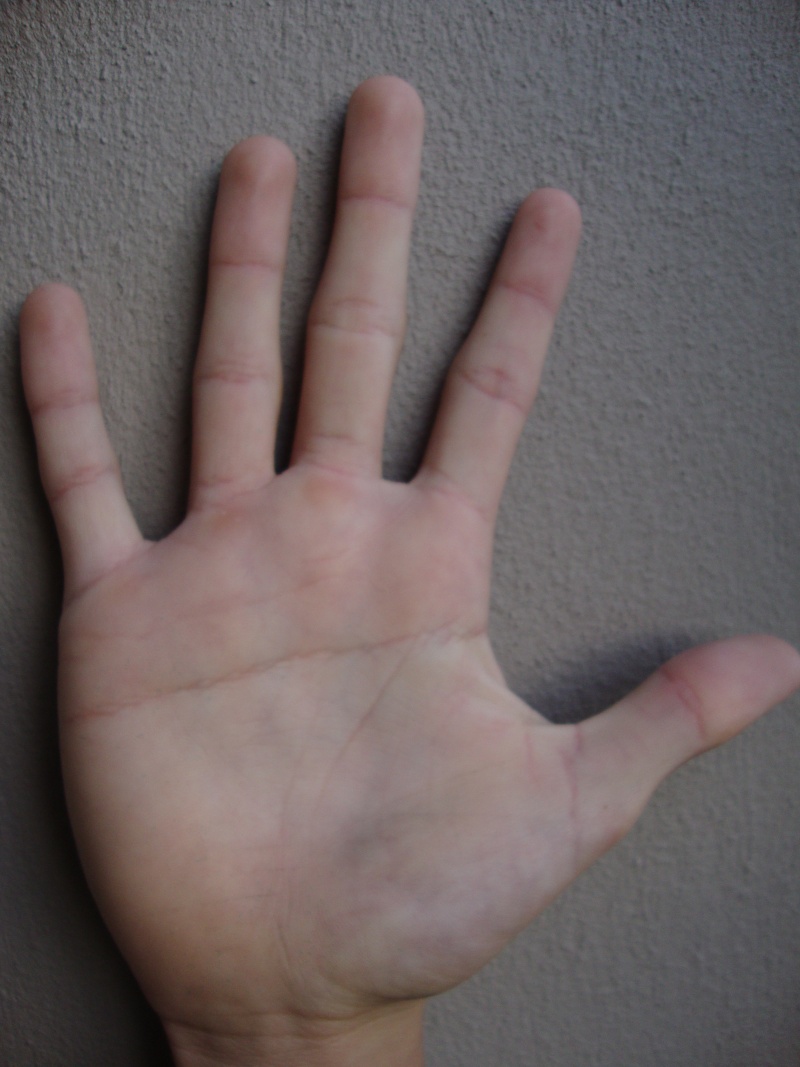
What do we know about the 'simian line'?
Well... actually, quite at lot!
A few general relatively well known aspects are:
1 - The 'simian line' is usually recognized as a fusion between heart line and head line.
2 - The 'simian line' is more often seen in various populations (including: men & asians).
3 - The 'simian line' is in medical science a.k.a. as: the single palmar transverse crease (or simian crease); and it has been recognized as a minor physical anomaly, which is especially well known for it's significance in Down's syndrome*.
* But the simian line has been linked with many other syndromes, diseases & certain psychological issues.
More details on all the mentioned aspects are presented here (9 sections describe different aspects of the simian line):
http://www.handresearch.com/diagnostics/simian-line.htm
 However...
However...
There is a problematic aspect about the 'simian line':
Because while the classic variant is relatively easy to recognize, it can manifest in many variants!!
Basically, one can discriminate a 'complete simian' from a 'incomplete simian line'.
But the major unanswered question here is:
'Can a 'complete simian line' have different implications than an 'incomplete simian line'?
Anyway, while there is litte evidence to answer this question permanently... in a recent study I discovered that this may indeed be true!!
Below I will describe my discovery by describing 2 observations that I made with the assistance of the 'PIC model' (which concerns a 'too' for classifying the major characteristics of the three palmar lines: life line + heart line + head line).
PS. More more details about the 'PIC-model' are available here:
http://www.handresearch.com/diagnostics/palmar-creases-hand-lines-pic.htm
* SIMIAN LINE OBSERVATION 1:
The 'complete simian line' is far les common than the 'incomplete simian line'!
THE DETAILS BEHIND OBSERVATION 1:
While the 'PIC-model' describes that the simian line can manifest in 12 different shapes (4 'complete simian line' variants + 8 'incomplete simian line variants')... usually the 'simian line' manifests in only 3 different variants:
1) The 'complete simian line' (PIC 211) - 1.1% in a Dutch population (N=400)
2) The 'distal disconnected simian line' (PIC 311d) - 1.6% in a Dutch population (N=400)
3) The 'distal simian line' (PIC 321d) - 5.2% in a Dutch population (N=400)
Overview of the 3 most common simian line variants: PIC 211, PIC 311d and PIC 321d.
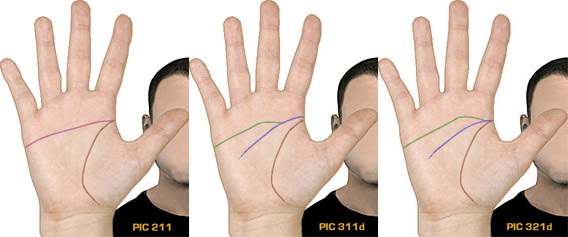
* SIMIAN LINE OBSERVATION 2:
The 'complete simian line' is often seen in Down's syndrome!
THE DETAILS BEHIND OBSERVATION 2:
Down syndrome is well known for having a very large occurence of the 'simian line', a study in 19 cases of Down syndrome revealed that the 'distal disconnected simian line' (PIC 311d) was not observed at all!
While the 'complete simian line' (PIC 211) was relatively common (21.0%), and the 'distal simian line' (PIC 321d) was even more common (23.7%)... one other usually more rare simian line variant was rrequently observed (7.9%): the 'distal simian-Sydney line' (PIC 322a+d) - see the picture below!
PS. I think the results for the 'distal simian-Sydney line' perfectly makes sense in the perspective that the 'Sydney line' is also a typical hand characteristic of the hand in Down's syndrome!

More details are presented at:
http://www.handresearch.com/diagnostics/hand-line-studies-formations-in-lines.htm

What do we know about the 'simian line'?
Well... actually, quite at lot!
A few general relatively well known aspects are:
1 - The 'simian line' is usually recognized as a fusion between heart line and head line.
2 - The 'simian line' is more often seen in various populations (including: men & asians).
3 - The 'simian line' is in medical science a.k.a. as: the single palmar transverse crease (or simian crease); and it has been recognized as a minor physical anomaly, which is especially well known for it's significance in Down's syndrome*.
* But the simian line has been linked with many other syndromes, diseases & certain psychological issues.
More details on all the mentioned aspects are presented here (9 sections describe different aspects of the simian line):
http://www.handresearch.com/diagnostics/simian-line.htm
 However...
However...There is a problematic aspect about the 'simian line':
Because while the classic variant is relatively easy to recognize, it can manifest in many variants!!
Basically, one can discriminate a 'complete simian' from a 'incomplete simian line'.
But the major unanswered question here is:
'Can a 'complete simian line' have different implications than an 'incomplete simian line'?
Anyway, while there is litte evidence to answer this question permanently... in a recent study I discovered that this may indeed be true!!
Below I will describe my discovery by describing 2 observations that I made with the assistance of the 'PIC model' (which concerns a 'too' for classifying the major characteristics of the three palmar lines: life line + heart line + head line).
PS. More more details about the 'PIC-model' are available here:
http://www.handresearch.com/diagnostics/palmar-creases-hand-lines-pic.htm
* SIMIAN LINE OBSERVATION 1:
The 'complete simian line' is far les common than the 'incomplete simian line'!
THE DETAILS BEHIND OBSERVATION 1:
While the 'PIC-model' describes that the simian line can manifest in 12 different shapes (4 'complete simian line' variants + 8 'incomplete simian line variants')... usually the 'simian line' manifests in only 3 different variants:
1) The 'complete simian line' (PIC 211) - 1.1% in a Dutch population (N=400)
2) The 'distal disconnected simian line' (PIC 311d) - 1.6% in a Dutch population (N=400)
3) The 'distal simian line' (PIC 321d) - 5.2% in a Dutch population (N=400)
Overview of the 3 most common simian line variants: PIC 211, PIC 311d and PIC 321d.

* SIMIAN LINE OBSERVATION 2:
The 'complete simian line' is often seen in Down's syndrome!
THE DETAILS BEHIND OBSERVATION 2:
Down syndrome is well known for having a very large occurence of the 'simian line', a study in 19 cases of Down syndrome revealed that the 'distal disconnected simian line' (PIC 311d) was not observed at all!
While the 'complete simian line' (PIC 211) was relatively common (21.0%), and the 'distal simian line' (PIC 321d) was even more common (23.7%)... one other usually more rare simian line variant was rrequently observed (7.9%): the 'distal simian-Sydney line' (PIC 322a+d) - see the picture below!
PS. I think the results for the 'distal simian-Sydney line' perfectly makes sense in the perspective that the 'Sydney line' is also a typical hand characteristic of the hand in Down's syndrome!

More details are presented at:
http://www.handresearch.com/diagnostics/hand-line-studies-formations-in-lines.htm
Last edited by Martijn (admin) on Sat Oct 04, 2014 9:29 pm; edited 6 times in total (Reason for editing : Title modification)
 Re: Simian line: advanced considerations!
Re: Simian line: advanced considerations!
NOTICE:
I am prepairing to present more 'PIC-model' results for other interesting populations, such as: for people who have an high IQ, autism, dyslexia, and for people who display typical personality characteristics (according the Big Five personality model).
So, I wouldn't be surprized if afterwards I can present more specied details about the occurence of various simian line variants in those populations!!
I hope this sounds like an interesting perspective!?

I am prepairing to present more 'PIC-model' results for other interesting populations, such as: for people who have an high IQ, autism, dyslexia, and for people who display typical personality characteristics (according the Big Five personality model).
So, I wouldn't be surprized if afterwards I can present more specied details about the occurence of various simian line variants in those populations!!
I hope this sounds like an interesting perspective!?

 Re: Simian line: advanced considerations!
Re: Simian line: advanced considerations!
During the past weeks I have prepaired further studies on the occurence of the 21 hand line variations (as described by the 'PIC model') in 2 other populations:
- 30 Dutch S.E.N. pupils (children who have 'Special Education Needs')
- 120 Dutch university students
Combined with the 2 populations that I already mentioned in my earlier post (19 people who have Down's syndrome + 400 people from the general Dutch population)... an interesting perspective has been established to study the basic idea that the three major hand lines might provide a clue about the Intelligence Quotiënt of individuals.
For, the 4 groups can be ranked as follows:
1) University studients = high IQ
2) General population = average IQ
3) S.E.N. pupils = moderate IQ
4) Down's syndrome = low IQ.
Actually, the PIC model results for each of the 4 groups are already available at the update page which I already introduced in my first post:
http://www.handresearch.com/diagnostics/hand-line-studies-formations-in-lines.htm
Regarding the results... I am now making a giant step ahead ... (
 )
)Well, I am very pleased that I can now report that the 'PIC model' has turned out to be a very helpfull tool to identify a (so far) relatively UNKNOW aspect of the hand...
... which appears to correlate HIGHLY with the I.Q. (intelligence) of individuals!!
 ... any idea???
... any idea???Anyway, time to present my third observation!!! (See my next post!)
Last edited by Martijn (admin) on Mon Sep 13, 2010 6:20 pm; edited 1 time in total
 Re: Simian line: advanced considerations!
Re: Simian line: advanced considerations!
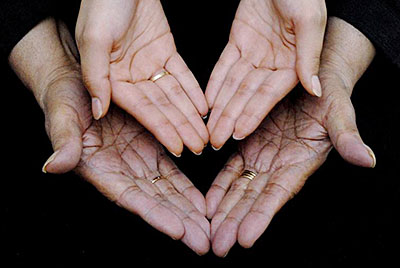
New results indicate that regarding the core patterns of the 3 major hand lines, asymmetries between the right hand and the left hand turn out to be a very significant factor that correlates with... the basic intelligence (IQ) of individuals.
* SIMIAN LINE OBSERVATION 3:
While judging the significance of a simian line, it is very important to consider as well the related-differences between the right hand and the left hand!
THE DETAILS BEHIND OBSERVATION 3:
First of all, I would like to quote a reminder which had already been established as a scientific fact:
"... various studies have indicated that the simian line is usually more frequently observed in the left-hand (1.3%) - compared to the right hand (0.8%)."
Basically, this implicates that hands show often a natural tendency towards simian line asymmetries!!!
Secondly, the study of the simian line results in the 4 groups has revealed that 'right hand versus left hand' differences (R-vs-L) are a key-factor in how the simian line correlates with IQ.
While small 'R-vs-L' differences are relatively unimportant (because they can be observed in about 1/3 of all people), a combination of 'R-vs-L' differences is much less common... but much more signficant in the perspective of the correlation between the simian line and (low) IQ.
Actually, certain combinations turn out to be observed only in the populations that are known to be featured with below average intelligence usually!!
A few of examples of the most significant combinations are:
Simian combi 1: 'Classic simian line' (PIC 201) in the right hand + the most normal hand line variant (PIC 201) in the left hand;
- Down syndrome: 5.26% (N: 1 out 19)
- S.E.N. pupils: 0% (N: 0 out of 30)
- Control population: 0% (N: 0 out of 400)
- University students: 0% (N: 0 out of 120)
Simian combi 2: 'Classic simian line' (PIC 201) in the right hand + 'Sydney line variant' (PIC 301a, PIC 311a, PIC 312a+b, PIC 312a+d or PIC 322a+b) in the left hand;
- Down syndrome: 5.26% (N: 1 out 19)
- S.E.N. pupils: 0% (N: 0 out of 30)
- Control population: 0% (N: 0 out of 400)
- University students: 0% (N: 0 out of 120)
Simian combi 3: 'Incomplete simian line variant' (PIC 311c, PIC 311d, PIC 311e, PIC 312a+d, PIC 312b+c, PIC 321c, PIC 321d, PIC 322a+d or PIC 322b+c) in the right hand + the most normal hand line variant (PIC 201) in the left hand;
- Down syndrome: 10.53% (N: 2 out 19)
- S.E.N. pupils: 6.67% (N: 2 out of 30)
- Control population: 0% (N: 16 out of 400)
- University students: 0.83% (N: 1 out of 120)
... combining these three asymmetrical 'R-vs-L' simian combinations (simian combi 1 + simian combi 2 + simian combi 3) results in the following distributions:
- Down syndrome: 21.05% (N: 4 out 19)
- S.E.N. pupils: 6.67% (N: 2 out of 30)
- Control population: 4.00% (N: 16 out of 400)
- University students: 0.83% (N: 1 out of 120)
These percentages clearly indicate that any 'simian line variant' in the right hand, combined with the most common hand line variant (PIC 310) or a 'Sydney line variant' (PIC 301a, PIC 311a, PIC 312a+b, PIC 312a+d or PIC 322a+b)... is much more likely found in a person from a population that is not known for having an above average 'Intelligence Coëfficient'!
Beyond the consideration of asymmetrical simian line combinations... of course one can also study the signficance of a simian line variant combi in both hands:
While the much more simple combination of any 'simian line variant' in both hands (which is sort of a symmetrical R-vs-L simian combination) leads to a far less impressive result:
- Down syndrome: 21.05% (N: 6 out 19)
- S.E.N. pupils: 0% (N: 0 out of 30)
- Control population: 3.50% (N: 14 out of 400)
- University students: 4.17% (N: 5 out of 120)
Though the results for a symmetrical R-vs-L simian line combination become a bit more impressive when only 'complete simian line variants' are considered:
- Down syndrome: 15.78% (N: 3 out 19)
- S.E.N. pupils: 0% (N: 0 out of 30)
- Control population: 1.0% (N: 4 out of 400)
- University students: 0% (N: 0 out of 120)
PS. I realize that what I have presented so far in this discussion is rather technical, so I already have designed a plan to write a much more simple article about how the major hand lines appear to correlate with intelligence!
 Re: Simian line: advanced considerations!
Re: Simian line: advanced considerations!

NOTICE: Picture above is just a nice illustration for fun!
* SIMIAN LINE OBSERVATION 4:
While 'complete simian lines' are more common in the left hand, a 'complete simian line' in the right hand appears to be more significant regarding intelligence!
SOME DETAILS ABOUT OBSERVATION 4:
Literature studies confirm that for example simian lines in the right hand combinated with relatively normal hand lines in the left hand are typical for in Down's syndrome.
While the reversed combi (simian line in left hand + normal lines in right hand) is a much more normal asymmetrical combination!
 ... I think OBSERVATION 4 should be quite easy to understand! Correct?
... I think OBSERVATION 4 should be quite easy to understand! Correct? Re: Simian line: advanced considerations!
Re: Simian line: advanced considerations!
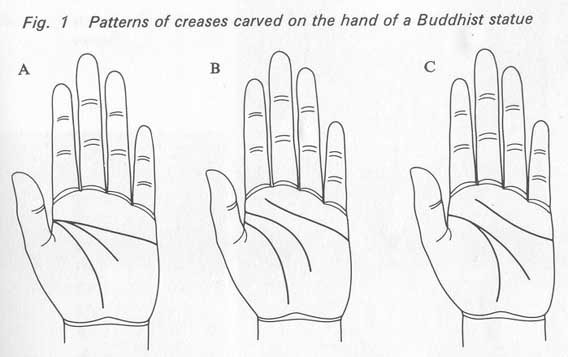
* SIMIAN LINE OBSERVATION 5:
Buddha statues often often show an (incomplete) simian line!
Hachiro Asano has described in his excellent book ''Hands - The Complete Book of Palmistry" (p.17), a very interesting observation:
"... The absence in their otherwise realistic sculputure of creases and lines indicates that the ancient Greeks were uninterested in palmistry. In contrast, in Indian and other oriental Buddhist sculpture, creases and lines are rendered clearly and in different ways to represent the characteristics of the particular Buddha: strong and vigorous for powerful masculine figures and gentle and romantic for feminine ones. The presence of lines and creases on the palms of such Buddhist statues is less widely recognized. In general, there are three patterns of creases, as shown in fig.1 [see picture above]. The most common is pattern A, which is found on the hands of many Japanese Buddhist statues, including the colossal Vairocana Buddha of the temple Tõdai-ji, in Nara. According to ancient doctrines of palmistry, this pattern is the most noble possible to human beings and an attribute of kings. Using it on sculpture representing them means that Buddhas are the most loftiest and most ideal form of humanity. In Japan, this palm pattern occurs in no more than seven out of every one hundred people and is often found in members of families of genius."
A few hand line examples in Buddha statues presented by Asano:
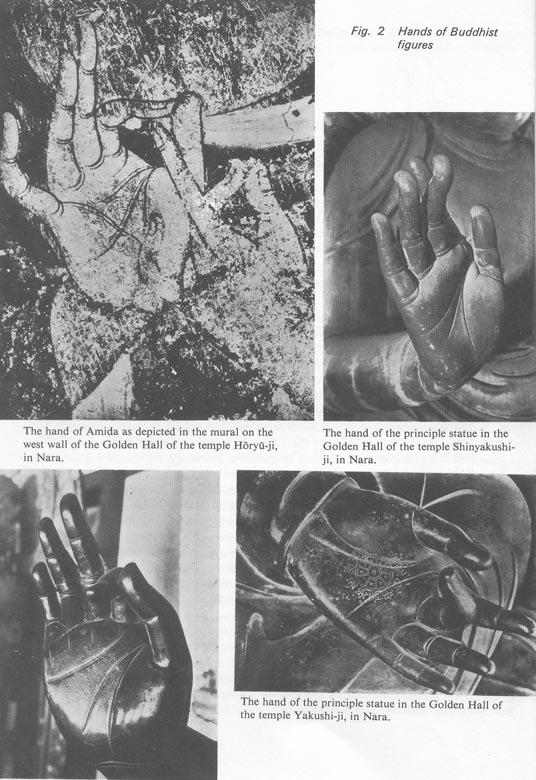
In the perspective of the Buddha sculptures, it is interesting to notice that the most common Buddha hand line type exactly relates to PIC type 321d (which is among Dutch people the most common simian-related hand line variant: observed in 5.25% in a population of 400 Dutch people - see table 1: http://www.handresearch.com/diagnostics/hand-line-studies-formations-in-lines.htm ).
But contrary to what is described by Asano about the Japanese population, this 'Buddha' hand line variant was less frequently found in sample of university students (4.17%). So, this suggests that also this 'Buddha' hand line variant should not be associated with a high IQ.
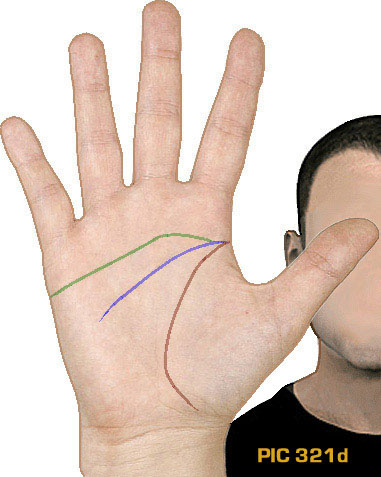
However...
 ... next to these results, the PIC model study has also identified a related hand line variant (which is less common) that has so far only been observed in BOTH HANDS of 3 female university students. This concerns PIC type 311d, see the picture below
... next to these results, the PIC model study has also identified a related hand line variant (which is less common) that has so far only been observed in BOTH HANDS of 3 female university students. This concerns PIC type 311d, see the picture below(To be continued!!)

 Re: Simian line: advanced considerations!
Re: Simian line: advanced considerations!
Thanks Martijn for these informative studies!
Boaz
Boaz

zaobhand- Posts : 751
Join date : 2010-08-10
 Re: Simian line: advanced considerations!
Re: Simian line: advanced considerations!
Hy Martijn,
thank you: An interesting case. I'm looking forward to further studies - specially for the last formation, the heart line going down to the head line start.
May be it would be interesting, which SL - in the left or right - has more effect on the whole life and on which part of the biography - childhood/youth, early or later adulthood.
Regards
Manfred
thank you: An interesting case. I'm looking forward to further studies - specially for the last formation, the heart line going down to the head line start.
May be it would be interesting, which SL - in the left or right - has more effect on the whole life and on which part of the biography - childhood/youth, early or later adulthood.
Regards
Manfred
 Re: Simian line: advanced considerations!
Re: Simian line: advanced considerations!
zaobhand wrote:Thanks Martijn for these informative studies!
Boaz

 Re: Simian line: advanced considerations!
Re: Simian line: advanced considerations!
Hi Manfred,Manfred wrote:Hy Martijn,
thank you: An interesting case. I'm looking forward to further studies - specially for the last formation, the heart line going down to the head line start.
May be it would be interesting, which SL - in the left or right - has more effect on the whole life and on which part of the biography - childhood/youth, early or later adulthood.
Regards
Manfred
I have started working on the development new model which also considers the 'splittings' in the heart line; and I am sure that later I will be able to report more details about that specific heart line variant.
Regarding left vs. right, I have noticed a major difference regarding the significance of the Syndey line (more 'troublesome' when present in the left hand) and the simian line (more 'troublesome' when present in the right hand).
But it might take a few more weeks/months before I can report more details.

 re: The simian line - advanced considerations!
re: The simian line - advanced considerations!
Martijn,
When I saw the mention of Buddha I was at once skeptical of what Asano was showing. Given that Buddhism did not arrive in Japan for at least one thousand years after Buddha's time, any statue in Japan would likely have no basis for comparison. That is, no model.
And, I have looked at many statues of the Buddha and note that some have very rudimentary depictions of palmar lines.
So, I did a little digging as I knew that the physical characteristics of the Buddha are actually well documented.
Have a look at this site which explains the 32 Main Signs of the Buddha:
The Signs of a Great Man
http://www.onmarkproductions.com/Signs-of-Buddha-32-80.htm
For instance:
2. he.t.thapaadatalesuu cakkani jaataani: 1,000 spoked wheel marks on soles (such marks would make the Buddha's hands and feet infinitely flexible -- unlike our hands and feet which can flex only in one or two directions because there are only two or three lines on our palms)
6. jaalahatthapaado: netlike lines on palms and soles (this is similar to no.2 -- it allows the feet and hands to be infinitely flexible -- it is not people of ancient times who had such a feature -- even Kuhn Yay Thongsuk Samdaengpan had such a feature on her hands which perhaps explains why she was so resiliant, even at a senior age when travelling to give teachings around the country)
Netlike? Wow! I cannot even imagine what that looks like.
Also, in the sub-characteristics you see:
21. lines on palms have rosy tint
38. lines on palms are deep
39. lines on palms are long
40. lines on palms are straight
41. lines on palms are have rosy-tint (repeat of 21?)
Lots of other interesting information in there as well. Have a look
When I saw the mention of Buddha I was at once skeptical of what Asano was showing. Given that Buddhism did not arrive in Japan for at least one thousand years after Buddha's time, any statue in Japan would likely have no basis for comparison. That is, no model.
And, I have looked at many statues of the Buddha and note that some have very rudimentary depictions of palmar lines.
So, I did a little digging as I knew that the physical characteristics of the Buddha are actually well documented.
Have a look at this site which explains the 32 Main Signs of the Buddha:
The Signs of a Great Man
http://www.onmarkproductions.com/Signs-of-Buddha-32-80.htm
For instance:
2. he.t.thapaadatalesuu cakkani jaataani: 1,000 spoked wheel marks on soles (such marks would make the Buddha's hands and feet infinitely flexible -- unlike our hands and feet which can flex only in one or two directions because there are only two or three lines on our palms)
6. jaalahatthapaado: netlike lines on palms and soles (this is similar to no.2 -- it allows the feet and hands to be infinitely flexible -- it is not people of ancient times who had such a feature -- even Kuhn Yay Thongsuk Samdaengpan had such a feature on her hands which perhaps explains why she was so resiliant, even at a senior age when travelling to give teachings around the country)
Netlike? Wow! I cannot even imagine what that looks like.
Also, in the sub-characteristics you see:
21. lines on palms have rosy tint
38. lines on palms are deep
39. lines on palms are long
40. lines on palms are straight
41. lines on palms are have rosy-tint (repeat of 21?)
Lots of other interesting information in there as well. Have a look
mooky- Posts : 102
Join date : 2011-03-30
Age : 66
Location : Michigan, USA
 Re: Simian line: advanced considerations!
Re: Simian line: advanced considerations!
I have spend some time updating the simian line section at my website, now available as a subdomain (illustrating it's significance):
http://simianline.handresearch.com
|

 Re: Simian line: advanced considerations!
Re: Simian line: advanced considerations!
excellent Martijn, that is very comprehensive & interesting simian line info. 

 Re: Simian line: advanced considerations!
Re: Simian line: advanced considerations!
Lynn wrote:excellent Martijn, that is very comprehensive & interesting simian line info.
Teşekkürler Lynn (thank you), nice to hear that you like it!
PS. I have additonal plans: because in the future I hope to present some kind of skedual with the purpose to give a quick impression regarding what is required for a simian line to become indicative for various specific chromosomal- and psychological conditions.
 simian lines
simian lines
Amazing and so ,so interesting.
Did you find out the significance of complete simian lines on both hands.
Thanks Martijn.
P.S. They say Robert de Niro is very introverted
Did you find out the significance of complete simian lines on both hands.
Thanks Martijn.
P.S. They say Robert de Niro is very introverted

jeanette- Posts : 568
Join date : 2010-07-27
Location : scotland
 Re: Simian line: advanced considerations!
Re: Simian line: advanced considerations!
jeanette wrote:Amazing and so ,so interesting.
Did you find out the significance of complete simian lines on both hands.
Thanks Martijn.
P.S. They say Robert de Niro is very introverted
Thanks Jeanette, great to hear that you like it.
Regarding your question, I think the principles are rather simple: a simian line in both hand has basically a stronger impact than a simian line in only one hand, and a complete simian line likely has basically a stronger impact than an incomplete simian line..
And I could add that so far I have not spotted any consistent tendencies for a single simian line in the right hand or left hand.
PS. Regarding Robert De Niro, if this is true... then his hands appear to present various clues that might explain this; because his hand prints at the Chinese Theatre (see picture below) suggest that next to his left hand complete simian line he also appears to have slightly long fingers, and a high 2d:4d digit ratio - which are three features that make together one of the strongest markers which became associated with introversion (= low score on the Big Five dimension Extraversion) in my study, see table 4 in this article:
http://www.handresearch.com/diagnostics/extraversion-ambiversion-introversion-hand-signs.htm
(By the way, I made these observations regarding De Niro's hand based on multiple photos taken from this tribute to his hands: http://www.handresearch.com/thumbs/robert-de-niro-thumbs-simian-line.htm )

 Re: Simian line: advanced considerations!
Re: Simian line: advanced considerations!
jeanette wrote:Amazing and so ,so interesting.
Did you find out the significance of complete simian lines on both hands.
Thanks Martijn.
P.S. They say Robert de Niro is very introverted
Confirmed!

Robert de Niro's Big Five profile shows that according his "public image" he is recognized to have an introverted personality.
NOTICE - This september 2018 article shows that there might be a connection between his introvertedness and his simian line:
Simian line: Big Five personality profiling - including Robert de Niro's simian line & Big FIve profile!

 Similar topics
Similar topics» Heart line dropping at head line or at mars mount(Simian Line )
» Is This a Island in Simian Line?
» FAMOUS SIMIAN LINES - Which famous persons have a 'simian line'?
» Crisis... will the next US president have a simian line?
» Can Partial Simian Line Change
» Is This a Island in Simian Line?
» FAMOUS SIMIAN LINES - Which famous persons have a 'simian line'?
» Crisis... will the next US president have a simian line?
» Can Partial Simian Line Change
Modern Hand Reading Forum - Discover the language of your hands: palm reading & palmistry forum! :: III - MODERN HAND READING - Various systems for reading hands! :: IIIa - Modern Palmistry: general topics, questions
Page 1 of 1
Permissions in this forum:
You cannot reply to topics in this forum





» Teacher square on my Jupiter mount
» Handreading International Conference 2024
» Can anyone read it for me?
» Are there any signs in the hands that you are a twin flame?
» Square on Marriage line
» Cross in mount Jupiter
» clinodactyly: top phalanges bending towards Mercury finger
» Can anybody please read this hand
» Nisha Ghai
» Absolutely non-sense career till now
» Fate Destiny Line -
» VIII - Palmistry books TOP 100 - listed by 'Amazon Sales Rank'!
» Stewart Culin - Palmistry in China and Japan
» Herbert Giles - Palmistry in China